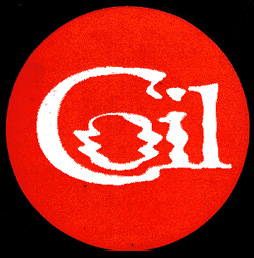the NachtKabarett
All Writing & Content © Nick Kushner Unless Noted Otherwise
Fellow Coil fans, I apologize for all the watermarks but am sick of having my original scans appropriated by assholes without even the courtesy of credit year after year.
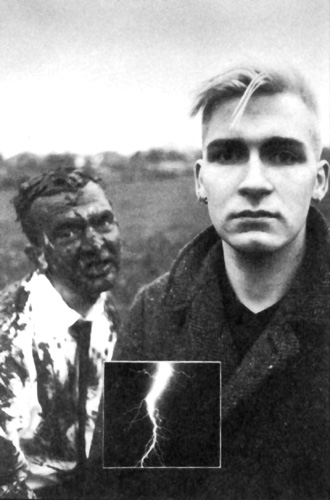 Coil: John Balance & Peter Christopherson. 1984.
Coil: John Balance & Peter Christopherson. 1984.Coil is without a doubt one of the most progressive, esoteric and influential groups of all time, as well as a personal favourite of the author, with a lifespan of nearly 3 decades. Formed in the early 1980's out of the ashes of industrial music founders, Throbbing Gristle, and later Psychic TV by the long time due of John Balance (aka Jhonn Balance) and Peter Christopherson, formerly of both aforementioned groups. Many today should be familiar with Peter "Sleazy" Christopherson or at least his creations as a video director for many modern day bands, particularly Nine Inch Nails' 'Pinion', 'Wish', 'Help Me I Am In Hell', 'Happiness In Slavery' and on the 'Closure' home video box set. In the group's later years before the untimely demise of John Balance on November 13, 2004 the band were briefly signed to Nothing Records, with many of the songs on their last album 'The Ape of Naples' being recorded in New Orleans in the Nothing studios, in addition to providing remixes for Nine Inch Nails since 1992.
Whenever describing Coil, the term 'band' is always one which I'm hesitant to use and most often describe them moreso as 'musical surrealism'. A consistent objective that John, Sleazy and their temporal collaborators strove for was the inversion of creating a visual image for which a soundtrack is to be written. Instead what the group did was create sonic imagery for the listener to form the visuals for within one's mind while listening. Each musical composition is a theme, a musical sketch, the soundtrack to a surrealist masterpiece which does not exist. Some of their best compositions remain true to traditional song structure such as 'Tainted Love', 'Anal Staircase', 'Slur', 'Panic' and 'Love's Secret Domain' (all actually from their earlier catalogue) but they remain a minority in the group's catalogue. Surprisingly though this does not detract. Coil composed the original score for the film Hellraiser which Clive Barker allegedly declined use of because the tracks were too terrifying. Or so accounts of the legend told. The results of which can be heard on the compilation 'Unnatural History II: Smiling in the Face of Perversity'.
The group, particularly John Balance, was incredibly deep in the occult and esoteric. Not just limited to imagery alone but moreso during the song creation process where such methods as attempting to channel spirits, Enochian calling, experimentation with mind altering substances to translate the experience into music and at times 10 to 16 minute compositions for the purpose of the composition playing an integral role in ritual magick and the evocation of energies.
Coil is best heard rather than described and their occultism is much more sonic than physical or in literal but their album artworks do contain many allusions and symbolisms which hearken their esoteric and occult influences. Below is a brief outline of much of the imagery the group have utilized.
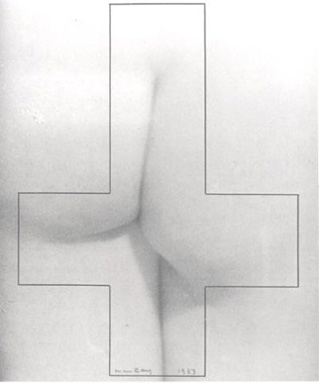 |
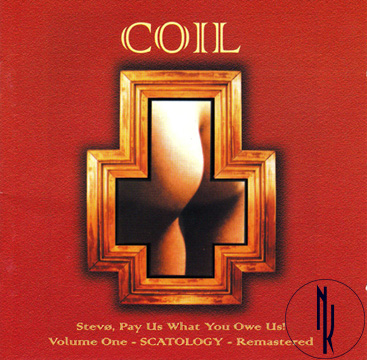 |
| Left, 'Monument to D.A.F. de Sade' by Man Ray. Right, 'Scatology', the seminal and incredibly influential 1984 album by Coil. | |
In 1984 Coil released a video for their version of 'Tainted Love' off the album Scatology. Marc Almond of Soft Cell has always remained a friend / collaborator of the group and only some three years prior Peter Christopherson directed their original cover the track. Coil's version however is an incredibly dark and harrowing reinterpretation whose melody is played with church bells. The single dually was the first ever music video which was added to the permanent video collection of the Museum of Modern Art and was also the first ever single whose profits would be donated solely to AIDS awareness charities.
The song title itself was reinterpreted as instead of being a pop euphemism for infatuation, heartbreak and break up, John and Peter being active members of the English gay nightlife saw firsthand the first onslaught of the AIDS epidemic, which the video illustrated tragically. 'Tainted Love'; literally an infected lover.
Additionally to the theme, the video contains several phantasmagoric and subliminal images, all of which relate to occultism and specifically to Aleister Crowley and The Law Of Thelema, who is himself something of an icon to the more esoteric gay community as being an early bisexual pioneer and author of early homosexual poetic writing, the most well known of which is 'White Stains'.
Many of the symbols appearing in the video are below:
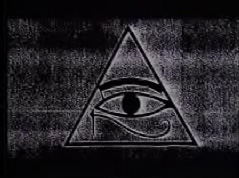 |
 |
| From left to right; The Eye of Horus, symbolic of Crowley's 'New Aeon' foretold in 'The Book of the Law'; and Crowley's unicursal hexagram (part of a larger montage, superimposed atop of such symbols as the 7 pointed star of Babalon and the pentagram). | |
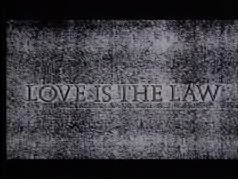 |
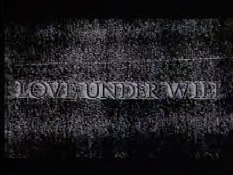 |
| "Love is the Law, Love Under Will", one half of Crowley's Law of Thelema, "Do What Thou Wilt Is The Whole Of The Law, Love Is The Law, Love Under Will". | |
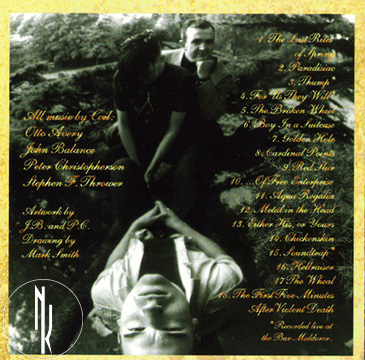 |
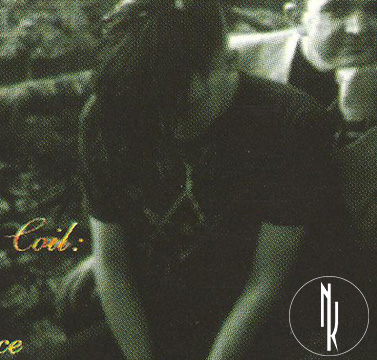 |
| Inlet cover of the album 'Gold Is The Metal With The Broadest Shoulders'. Right, detail of founding member and the group's occult influence, John Balance (aka Jhonn Balance) wearing a unicursal hexagram t-shirt. | |
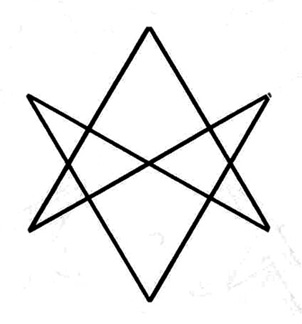 The Unicursal Hexagram adopted and stylized by Aleister Crowley in the early Twentieth Century is a derivation of the hexagram commonly referred to as The Star Of David. Just as the symbolism of the traditional hexagram consisted of two interlocked triangles, one pointing up and one pointing down to symbolize the occult principle of balance, "as above so below" the Unicursal Hexagram represents as such but drawn so with an unbroken line to signify continuous movement.
The Unicursal Hexagram adopted and stylized by Aleister Crowley in the early Twentieth Century is a derivation of the hexagram commonly referred to as The Star Of David. Just as the symbolism of the traditional hexagram consisted of two interlocked triangles, one pointing up and one pointing down to symbolize the occult principle of balance, "as above so below" the Unicursal Hexagram represents as such but drawn so with an unbroken line to signify continuous movement.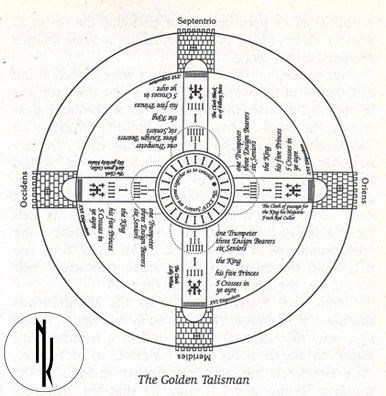 |
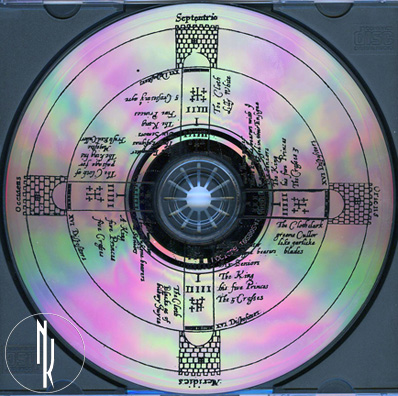 |
| Right, scan of Coil's 'Angelic Conversations' CD, the soundtrack to Derek Jarman's 1986 underground film. Left, the original talisman printed atop the disc. In this case taken from Donald Tyson's 'Enochian Magick for Beginners'. Enochian is the language held to be spoken by angels with Enochian Magick being the path of invocations and evocations of angels and their powers. | |
Enochian Magick for Beginners by Donald TysonAnalysis Of The Great Vision
Kelley sees four castles standing in the four quarters of the world. Ave informs Dee that these castles , which he calls "houses," are the four angels of the Earth, who are also the four overseers and Watchtowers- it is not uncommon in magic for a place or thing to also be a spirit.
On Dee's golden talisman, these castles are depicted as medieval stone towers each with seven battlement stones (the northern tower has eight stones), one small square window containing four panes, and a large, open semicircular gate. The seven battlement stones stand for the traditional planets of astrology, the square window represents the letter square of the Watchtower on the Great Table, and the arch of the gate is the crescent of the moon, through whose sphere all heavenly beings must pass on their journey to the Earth.
This symbolism was probably unconscious, which would account for the eight battlement stones on the northern tower (unless this number has some hidden significance). The four Watchtowers are depicted similarly on the medallion, with only minor variations, so Dee probably intended them to be perceived as identical. It should be noted that in the engraving of the medallion in Casaubon the colors of the four cloths are inverted top to bottom and left to right. The engraver shows green in the east, red in the west, black in the south and white in the north. I have restored the colors to the arrangement described in Kelley's vision. This inversion was not an error by the engraver- it also appears on the original golden medallion in the British Museum. Dee may well have had some reason for inverting the colors, and it may be the same reason the Enochian letters were inverted on the actual Table of Practice from the arrangement in Dee's manuscript drawing of the table. However, since I can think of no good reason for changing the colors in Kelley's vision, I have put the colors in the same relative positions on the medallion.
Ave states that the Watchtowers were placed at the extremities of the world by God "against the usurping blasphemy, misuse, and stealth of the wicked and great enemy, the Devil." They act as a limiting influence on the chaotic works of the Devil upon the Earth, and are necessary in order to preserve living creatures "within the compass and measure of order." Thye do not entirely exclude the influence of Satan, or prevent him from affecting the world, but check and bridle his malice to a degree that allows the orderly fulfillment of the "determinations of God." When Satan seeks to exceed that limit, the angels of the Watchtowers exert their power, and the Devil "feeleth he the bit."
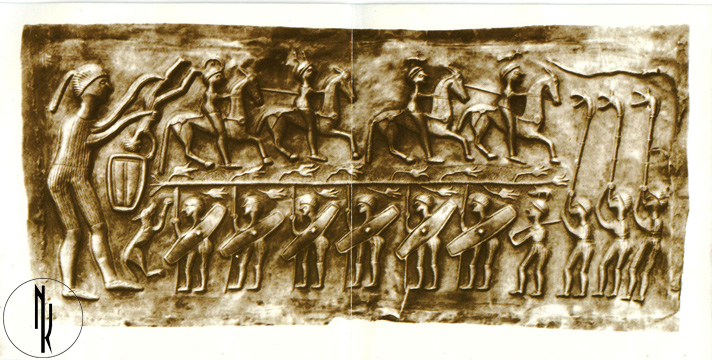 Interior artwork of Coil's 'How To Destroy Angels'
Interior artwork of Coil's 'How To Destroy Angels'In this detail from the Gundestrup cauldron, three soldiers - to the right of the two-row military procession - blow wold-headed trumpets. At left a large figure dangles a smaller one over a vessel in what may be a bloodletting sacrifice - reflecting, perhaps, the original use of the cauldron.The Emergence of Man by Thomas Francek and the editors of Time-Life Books
The origins of the singular image within the reissue of Coil's 'How To Destroy Angels' is a detail of a much larger silver cauldron created by an ancient Danish tribe. The detail in question, as quoted above, pertains to ritual sacrifice to their antiquated deities. The full, reassembled cauldron is below.
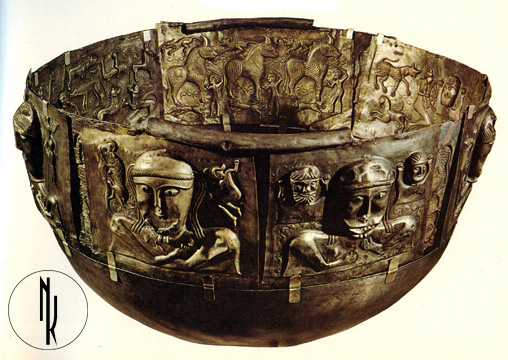 The entire reassembled cauldron, which the above detail is a piece of.
The entire reassembled cauldron, which the above detail is a piece of.The Emergence of Man by Thomas Francek and the editors of Time-Life BooksThe embossed Gundestrup cauldron, painstakingly reassembled and restored, shows few signs of its 2,000 year immersion in a Danish bog.
In 1891, in a remote part of Jutlan, a peat cutter laid bare a portion of the most dazzling ancient treasure ever unearthed in Denmark: the silver Gundestrup cauldron named for the township in which it was found.... The only thing certain about its history is that the early Danes dismantled its plates and laid the pieces on the bog as a sacrifice to their gods.
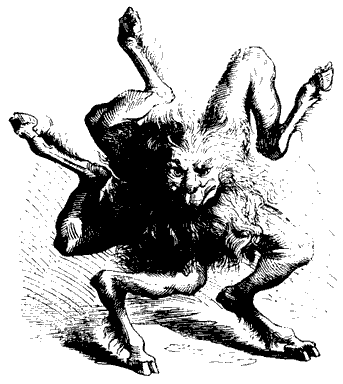 |
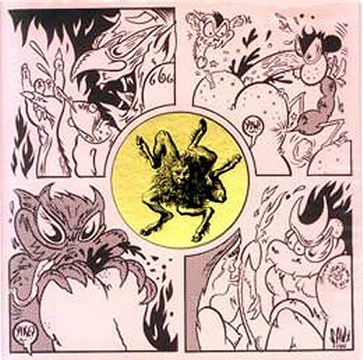 |
| Right, the cover of Coil's 'Wrong Eye' / 'Scope' single which contains in its center the demon Buer from the Goetia, horizontally inverted | |
The Tenth Spirit is Buer, a Great President. He appeareth in Sagittary, and that is his shape when the Sun is there. He teaches Philosophy, both Moral and Natural, and the Logic Art, and also the Virtues of all Herbs and Plants. He healeth all distempers in man, and giveth good Familiars. He governeth 50 Legions of Spirits, and his Character of obedience is this, which thou must wear when thou callest him forth unto appearance.The Goetia or Lesser Key of Solomon
The Goetia is also known as the Lesser Key of Solomon, a guide to the evocation of so-called "demons" or, more accurately, lesser, incomplete, vice-obsessed angels, those who aid in the procuration of sex, money and earthly pleasures. The grimoire which originates from a circa 16th Century manuscript was originally begun exhumed by S. Liddell Macgregor Mathers, co-founder of the occult organization The Golden Dawn, and later translated and published by Aleister Crowley in the early years of the Twentieth Century.
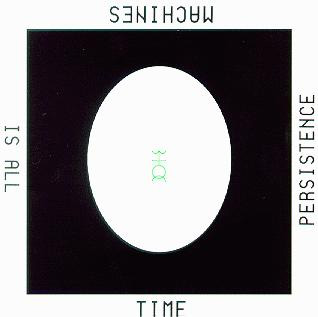 Artwork from Coil's 1998 album Time Machines. The center figure is, father of Enochian Magick, John Dee's Hieroglyphic Monad inverted.
Artwork from Coil's 1998 album Time Machines. The center figure is, father of Enochian Magick, John Dee's Hieroglyphic Monad inverted.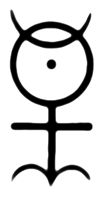 John Dee's Hieroglyphic Monad. The make up of the glyph is created through the unity of the 7 symbols of the alchemical planetary elements and is representative of the singular unity of all existence.
John Dee's Hieroglyphic Monad. The make up of the glyph is created through the unity of the 7 symbols of the alchemical planetary elements and is representative of the singular unity of all existence.
Coil Links:
- http://brainwashed.com/coil - Group history, discography. Great site, personal favourite. 'Time Machines', 'Wrong Eye' and Scatology group shot are courtesy of Brainwashed.
- http://www.myspace.com/thresholdhouse - Peter Christopherson's active MySpace page.
- http://www.thresholdhouse.com - Official Coil site / record label.
